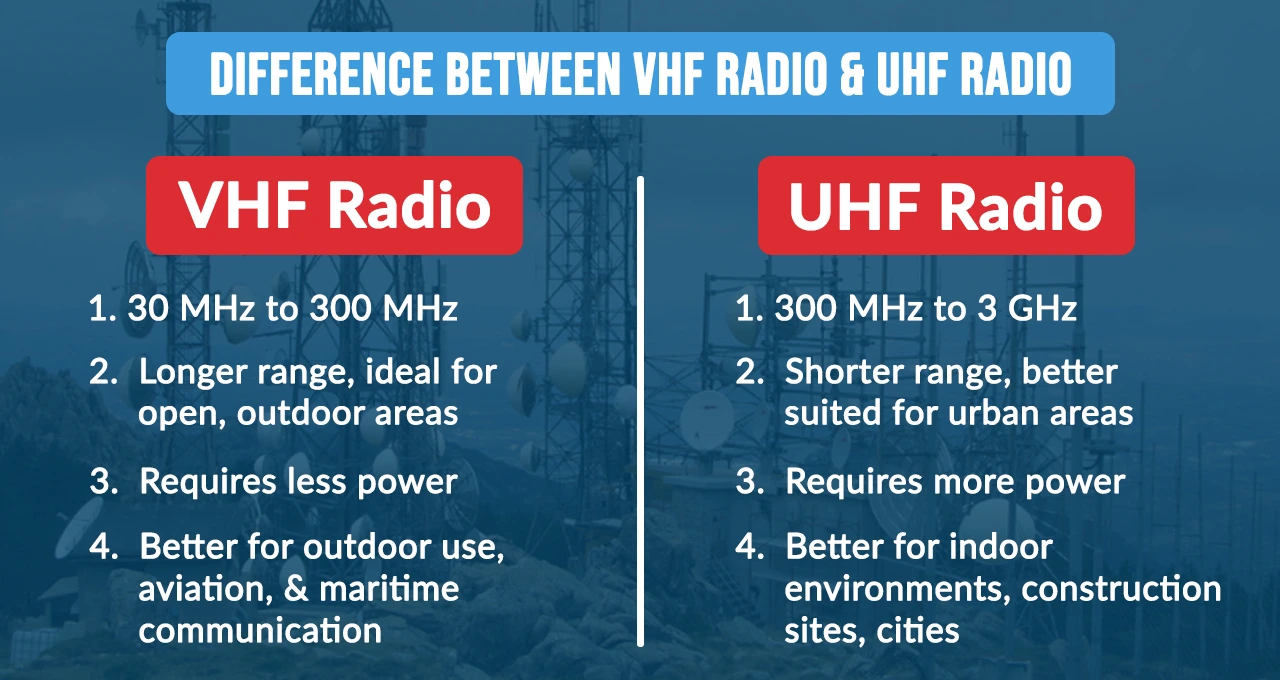
Depending on the size and location of the operation, larger or smaller businesses may require different frequency ranges. Though UHF and VHF comes with their own set of advantages and limitations, knowing the differences will help you decide which best suits your needs.
UHF and VHF- An Overview
Very High frequency (VHF) is ideal for large areas and open spaces since it offers a larger broadcast range. It is also cheaper compared to FM, and it provides high-quality audio over long distances of as far as 100 miles, depending on the terrain.
However, the signal of VHF goes through metal or concrete badly; hence, it is easily disrupted in highly structure-based areas. It is mainly applied to agriculture, marine communication, and outdoor activities.
Ultra High Frequency (UHF)
—These waves are much shorter, offering a smaller radius; however, they perform better indoors and in cities or towns. Radios using UHF frequency are smaller in size because of the antenna size and thus are more feasible for use among obstacles such as buildings.
Significant Uses of UHF and VHF Radios
VHF Radios:
These radios are best for staff working in wide, open spaces with minimal interference from buildings or structures. However, since VHF radios are very common, signal congestion may occur in some areas.
UHF Radios:
While UHF radios work especially well in environments with a high concentration of metal or concrete or in dense forests, they are ideal for indoor or very populated areas. Most public safety personnel, such as the police, fire, and EMS, find UHF radios quite useful for their work. However, these UHF radios usually have shorter battery life and must be charged more often.
Key Differences Between UHF and VHF Radios
Let’s have a look at the difference between VHF and UHF radios for better understanding.
Signal Strength
VHF: Serves better over long distances in open areas but can be easily interfered with by any form of obstacle.
UHF: Brings up strong signal strength over shorter distances and is positive enough to pass through buildings and obstructions.
Distance
VHF: Suitable in open areas and meant for long-distance communications whose signals can go up to 100 miles or more.
UHF: Can be best utilised over shorter ranges of distances in obstacle-filled places, such as cities.
Interference
VHF: Fewer channels are available; hence, this bandwidth is easily congested and interfered with by other radios in the vicinity.
UHF: Work better in areas with several short-range signals, hence less interference.
Type of Signal
VHF: Frequency of 30-300 MHz, excellent over flat ground and very poor indoors.
UHF: Frequency of 403-470 MHz, fair over distance and works well indoors.
Application
VHF: Widely used in outdoors industries such as forestry, marine operations, golf courses, and oil.
UHF: best used for public safety, schools, medical staff, warehouses, and retail.

VHF and UHF Radio- Get Communication Solutions Built for Purposes
TE (PNG) LTD is a leading provider of communication solutions in Papua New Guinea. Our technicians are experts in designing, installing and maintaining communication networks to meet individual needs and suit the PNG environment.
With over 25 years of experience in working with world-class brands and delivering innovative communication solutions in PNG, we can provide only the highest standards of quality. After considering the PNG environment to ensure customer satisfaction, we present a long line of products with innovative design solutions.
Explore a variety of cutting-edge solutions for fixed fibre and copper networks, HF, VHF and UHF radio, high end VSAT, satellite phone and internet services, digital phone systems and PTT over cellular, asset/vehicle monitoring, CCTV and security systems and more.
Visit our website to check out our inventory and place your order.

